Firs House - The restoration of a historic listed property
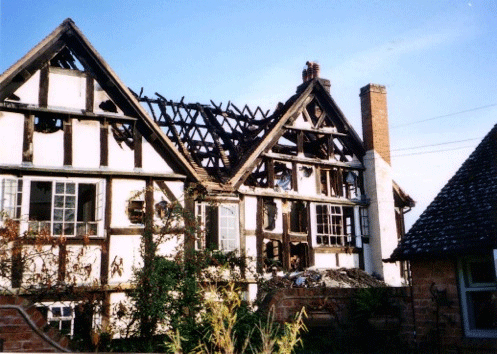 The renovation of a historic period house can be a challenging and rewarding, but also a heartbreaking experience, particularly when you see your ‘labour of love’ burn down and have to start the whole restoration process again.
The renovation of a historic period house can be a challenging and rewarding, but also a heartbreaking experience, particularly when you see your ‘labour of love’ burn down and have to start the whole restoration process again.
This is what happened at Firs House, a spectacular Grade II listed property in Worcestershire. Originally, a detached green-oak-framed farmhouse, dating back to the seventeenth century, the two storey building was designed in the classic sixteenth/seventeenth century ‘T’ shape with a main range and a cross wing on the north end. What is now used as the front of the property was 17th Century in origin and was the principal elevation when built, but extensive alterations had been made during the Georgian and Victorian eras at what is now the back of the property again.
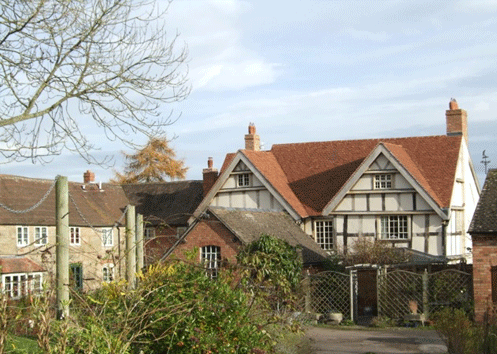 After six years of painstaking restoration, disaster struck in the middle of one night in November 2006, when the owners, Penny and Mark Soper were woken up by a strange sound coming from the attic. “At first, we thought the noise was due to the family cat playing with a marble on the exposed wooden floor, but then the lights went out and white hot flames were visible around the trapdoor into the roof void. As we ran outside, we saw flames shooting from the roof and clay tiles dramatically exploding like shrapnel off the roof,” said Penny.
After six years of painstaking restoration, disaster struck in the middle of one night in November 2006, when the owners, Penny and Mark Soper were woken up by a strange sound coming from the attic. “At first, we thought the noise was due to the family cat playing with a marble on the exposed wooden floor, but then the lights went out and white hot flames were visible around the trapdoor into the roof void. As we ran outside, we saw flames shooting from the roof and clay tiles dramatically exploding like shrapnel off the roof,” said Penny.
The scene was devastating. Severe damage had been done to the timber framing of the upper part of the oldest part of the house, and the now unsupported 17th Century gables of the front elevation tilted at an angle. The whole of the roof structure and first floor ceilings were destroyed beyond re-use with only two rafters remaining. In addition, there was substantial water damage to the suspended timber floors, ceilings and lath and plaster partitions from the attempts to extinguish the fire and from the ensuing winter and wet weather. Areas of the old oak floors on the first floor were damaged by pieces of burning bituminous roofing felt and hot roof tiles dropping from above and continuing to burn right through the floorboards.
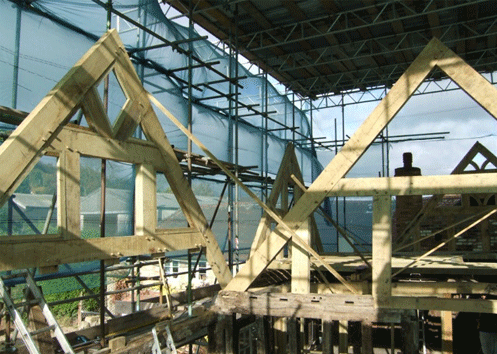 It was discovered that the cause of the blaze was an electrical fault in the roof space, underneath the bitumen felt underlay. Unfortunately, none of the smoke detectors activated during the fire, as the heat and the smoke was above them, and there were no detectors located in the roof space itself, where they could have been more effective.
It was discovered that the cause of the blaze was an electrical fault in the roof space, underneath the bitumen felt underlay. Unfortunately, none of the smoke detectors activated during the fire, as the heat and the smoke was above them, and there were no detectors located in the roof space itself, where they could have been more effective.
In 2007, the major task of structural repair and rebuild began, masterminded by Alex Matthews and Nick Joyce, partners at Nick Joyce Architects, a practice which specialises in the conservation and renovation of historic and heritage properties. After conducting an extensive survey, plans were put together to restore and upgrade this unique building, while taking every care to conserve or recycle original materials where possible.
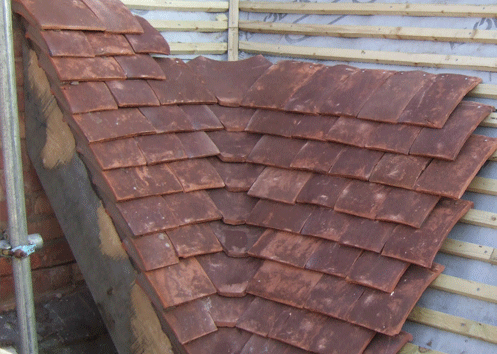 Local building company, Brothwell & Miles was appointed to undertake the painstaking structural repair and reconstruction of most of the timber frame and roof structure using oak trusses and oak purlins with concealed steel members to recreate as much as possible of the original appearance, shape and construction, whilst bringing the roof members up to modern building standards. Timbers and traditional joints were cut on site in the traditional way of construction.
Local building company, Brothwell & Miles was appointed to undertake the painstaking structural repair and reconstruction of most of the timber frame and roof structure using oak trusses and oak purlins with concealed steel members to recreate as much as possible of the original appearance, shape and construction, whilst bringing the roof members up to modern building standards. Timbers and traditional joints were cut on site in the traditional way of construction.
In addition to re-using surviving floor timbers and preserving original features, the reconstruction also represented an opportunity to upgrade the property with some modern materials, without compromising the aesthetics or historical integrity of the original, though all changes and all new materials had to be given Listed Building Consent before they could be incorporated.
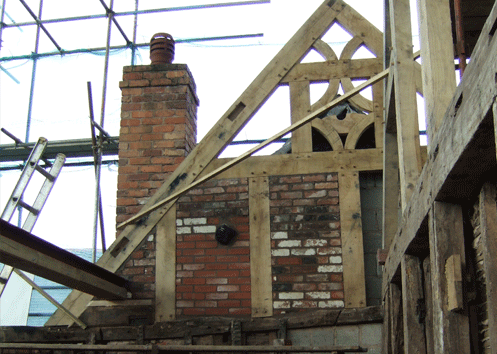 For instance, although some of the original lath and plaster was still in place in two of the ground floor rooms, in other parts it had already been replaced by plasterboard in the 1980s so, in these instances, modern composite rigid-foam insulated plasterboard panels were used. Modern damp-proof coursing was also injected where appropriate. Lath and lime plaster were used throughout the hallway, landing and stairs complete with limewash, to create an authentic historic feel to the core of the house - the first spaces which visitors see on arrival.
For instance, although some of the original lath and plaster was still in place in two of the ground floor rooms, in other parts it had already been replaced by plasterboard in the 1980s so, in these instances, modern composite rigid-foam insulated plasterboard panels were used. Modern damp-proof coursing was also injected where appropriate. Lath and lime plaster were used throughout the hallway, landing and stairs complete with limewash, to create an authentic historic feel to the core of the house - the first spaces which visitors see on arrival.
“As some of the house had already been compromised during the twentieth century, we took a sensitive but pragmatic approach to the overall conservation, replicating the original style and features where we could, but also introducing modern structural materials where necessary,” said Alex Matthews.
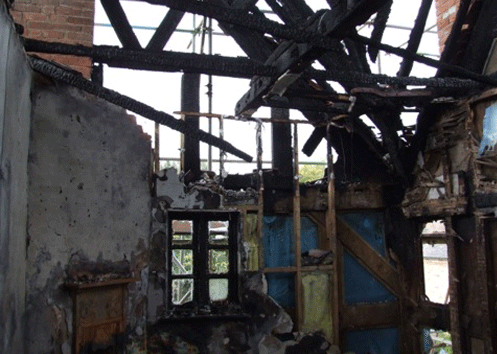 A modern breathable membrane was fitted on the new roof and the original tiles were replaced by 6,000 traditional handmade plain clay tiles from Tudor Roof Tile Co Ltd. Manufactured in ‘Medium Antique’, their gently uneven shapes gave an instantly aged and ‘olde world’ appearance that closely reproduced the mellow tone and texture of the originals, in a way that machine-made tiles could not have done. Their gentle double camber also offered added ventilation to the roof space.
A modern breathable membrane was fitted on the new roof and the original tiles were replaced by 6,000 traditional handmade plain clay tiles from Tudor Roof Tile Co Ltd. Manufactured in ‘Medium Antique’, their gently uneven shapes gave an instantly aged and ‘olde world’ appearance that closely reproduced the mellow tone and texture of the originals, in a way that machine-made tiles could not have done. Their gentle double camber also offered added ventilation to the roof space.
“The choice of roof tiles was an important part of restoring the external appearance and character of the building. We wanted to use traditionally made plain tiles with a weathered look that would immediately blend in with the historic appearance of the building and be acceptable to the local authority planning officers, said Alex Matthews.
“As we had worked with Tudor Roof Tiles several times in the past, we knew that we could rely on the quality of their plain tiles and so, as more than one blend could have been suitable, the ultimate choice was made by the owners.”
As the pitch of the gablet roofs was much the same as the roof of the main range, it was possible to use Tudor’s purpose-made tiles for swept valleys. This is another feature which helps to give an aged, traditional appearance to the house, which would not have been the case with lead lined valleys.
In the interior, the magnificent finely detailed Georgian balustrade to the main staircase was also rebuilt by a cabinet maker, using traditional methods. An unsightly seventies fireplace in the seventeenth century dining room with exposed timber-framed walls and ceiling beams was replaced by a more appropriate inglenook-style fireplace with oak mantel and stove.
The owners decided to gain some benefit from the unplanned reconstruction, by taking the opportunity to create a new room in the previously unused attic and inserting a new connecting staircase. To light this space, traditional oak casement windows were fitted into what had been blind gables of the timber-framed elevation, in panels where the original 17th century building would have had windows. In addition, a cloakroom with a new window was inserted in a ground floor room.
Naturally, the prevention of the possibility of another fire in the future was a primary consideration throughout. Fireplaces and chimneys were rebuilt with fire precautions in place and the roof space was divided into three zones with half hour fire resistant partitions between them. As the electrics were replaced, heat detectors and smoke detector alarms were fitted throughout the house.
For Penny and her family, rebuilding Firs House has been a challenging but immensely rewarding experience. “To say it was a labour of love is an understatement. Completing this massive restoration has been a remarkable achievement, largely down to the expertise of our architect and the hard work and support of the contractors and manufacturers involved.”
Tudor roof tiles are available from leading roofing and builders merchants. For more information, contact Tudor Roof Tile Co. Ltd, Dengmarsh Road, Lydd, Kent, TN29 9JH. Tel: 01797 320202 Fax 01797 320700 E-mail: This email address is being protected from spambots. You need JavaScript enabled to view it. Website: www.tudorrooftiles.co.uk















